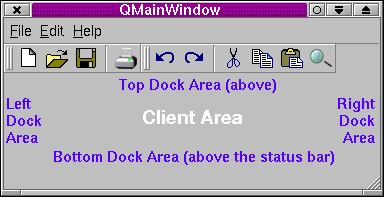| Home | All Classes | Main Classes | Annotated | Grouped Classes | Functions |
The QDockArea class manages and lays out QDockWindows. More...
#include <qdockarea.h>
Inherits QWidget.
A QDockArea is a container which manages a list of QDockWindows which it lays out within its area. In cooperation with the QDockWindows it is responsible for the docking and undocking of QDockWindows and moving them inside the dock area. QDockAreas also handle the wrapping of QDockWindows to fill the available space as compactly as possible. QDockAreas can contain QToolBars since QToolBar is a QDockWindow subclass.
QMainWindow contains four QDockAreas which you can use for your QToolBars and QDockWindows, so in most situations you do not need to use the QDockArea class directly. Although QMainWindow contains support for its own dock areas it isn't convenient for adding new QDockAreas. If you need to create your own dock areas we suggest that you create a subclass of QWidget and add your QDockAreas to your subclass.

Lines. QDockArea uses the concept of lines. A line is a horizontal region which may contain dock windows side-by-side. A dock area may have room for more than one line. When dock windows are docked into a dock area they are usually added at the right hand side of the top-most line that has room (unless manually placed by the user). When users move dock windows they may leave empty lines or gaps in non-empty lines. Dock windows can be lined up to minimize wasted space using the lineUp() function.
The QDockArea class maintains a position list of all its child dock windows. Dock windows are added to a dock area from position 0 onwards. Dock windows are laid out sequentially in position order from left to right, and in the case of multiple lines of dock windows, from top to bottom. If a dock window is floated it still retains its position since this is where the window will return if the user double clicks its caption. A dock window's position can be determined with hasDockWindow(). The position can be changed with moveDockWindow().
To dock or undock a dock window use QDockWindow::dock() and QDockWindow::undock() respectively. If you want to control which dock windows can dock in a dock area use setAcceptDockWindow(). To see if a dock area contains a particular dock window use hasDockWindow(); to see how many dock windows a dock area contains use count().
The streaming operators can write the positions of the dock windows in the dock area to a QTextStream. The positions can be read back later to restore the saved positions.
Save the positions to a QTextStream:
ts << *myDockArea;
Restore the positions from a QTextStream:
ts >> *myDockArea;
See also Main Window and Related Classes.
A dock window has two kinds of handles, the dock window handle used for dragging the dock window, and the splitter handle used to resize the dock window in relation to other dock windows using a splitter. (The splitter handle is only visible for docked windows.)
This enum specifies where the dock window splitter handle is placed in the dock area.
Does not affect any floating dock windows or dock windows in other dock areas, even if they first appeared in this dock area. Floating dock windows are effectively top level windows and are not child windows of the dock area. When a floating dock window is docked (dragged into a dock area) its parent becomes the dock area.
Returns the number of dock windows in the dock area. See the "count" property for details.
Returns where the dock window splitter handle is placed in the dock area. See the "handlePosition" property for details.
See also setAcceptDockWindow().
Returns TRUE if the dock area is empty; otherwise returns FALSE. See the "empty" property for details.
Moves the dock window w inside the dock area where p is the new position (in global screen coordinates), r is the suggested rectangle of the dock window and swap specifies whether or not the orientation of the docked widget needs to be changed.
This function is used internally by QDockWindow. You shouldn't need to call it yourself.
Returns the dock area's orientation. See the "orientation" property for details.
You should never need to call this function yourself. Use QDockWindow::dock() and QDockWindow::undock() instead.
See also isDockWindowAccepted().
This property holds the number of dock windows in the dock area.
Get this property's value with count().
This property holds whether the dock area is empty.
Get this property's value with isEmpty().
This property holds where the dock window splitter handle is placed in the dock area.
The default position is Normal.
Get this property's value with handlePosition().
This property holds the dock area's orientation.
There is no default value; the orientation is specified in the constructor.
Get this property's value with orientation().
Writes the layout of the dock windows in dock area dockArea to the text stream ts.
See also operator>>().
Reads the layout description of the dock windows in dock area dockArea from the text stream ts and restores it. The layout description must have been previously written by the operator<<() function.
See also operator<<().
This file is part of the Qt toolkit. Copyright © 1995-2007 Trolltech. All Rights Reserved.
| Copyright © 2007 Trolltech | Trademarks | Qt 3.3.8
|